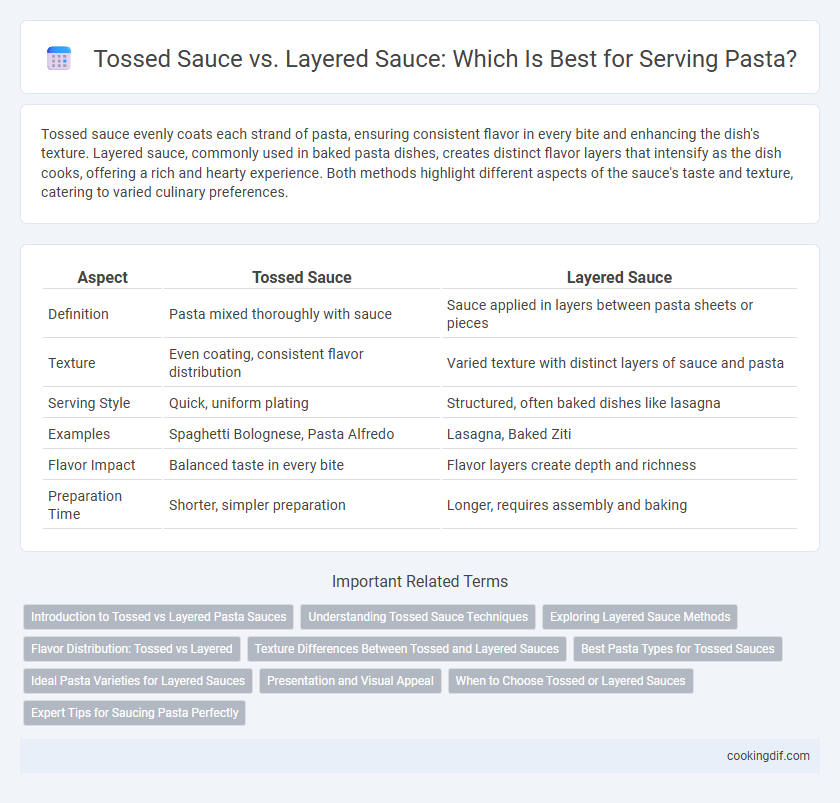Tossed sauce evenly coats each strand of pasta, ensuring consistent flavor in every bite and enhancing the dish's texture. Layered sauce, commonly used in baked pasta dishes, creates distinct flavor layers that intensify as the dish cooks, offering a rich and hearty experience. Both methods highlight different aspects of the sauce's taste and texture, catering to varied culinary preferences.
Table of Comparison
| Aspect | Tossed Sauce | Layered Sauce |
|---|---|---|
| Definition | Pasta mixed thoroughly with sauce | Sauce applied in layers between pasta sheets or pieces |
| Texture | Even coating, consistent flavor distribution | Varied texture with distinct layers of sauce and pasta |
| Serving Style | Quick, uniform plating | Structured, often baked dishes like lasagna |
| Examples | Spaghetti Bolognese, Pasta Alfredo | Lasagna, Baked Ziti |
| Flavor Impact | Balanced taste in every bite | Flavor layers create depth and richness |
| Preparation Time | Shorter, simpler preparation | Longer, requires assembly and baking |
Introduction to Tossed vs Layered Pasta Sauces
Tossed pasta sauce is mixed thoroughly with the noodles, ensuring an even coating that enhances every bite with consistent flavor distribution. Layered pasta sauce, often used in baked dishes like lasagna, involves alternating layers of sauce and pasta, creating distinct taste combinations and textures in each portion. Understanding the difference between these methods helps in selecting the right sauce technique to complement the desired pasta dish.
Understanding Tossed Sauce Techniques
Tossed sauce techniques involve coating pasta evenly by combining it directly with the sauce, enhancing flavor absorption and texture consistency. This method ensures every strand or piece is lightly enveloped, creating a harmonious blend of taste and moisture. Understanding proper tossing methods, such as using a large pan and gentle heat, prevents clumping and promotes a balanced sauce-to-pasta ratio.
Exploring Layered Sauce Methods
Layered sauce methods in pasta dishes like lasagna offer distinct texture and flavor profiles by stacking rich sauces with cheese and pasta sheets, creating a harmonious blend that evenly distributes taste in every bite. This technique contrasts with tossed sauces, where pasta is mixed uniformly with sauce, often leading to a quicker, less concentrated flavor experience. Exploring layered sauces enhances culinary complexity and presentation, making it ideal for dishes requiring baking and melding of ingredients.
Flavor Distribution: Tossed vs Layered
Tossed sauce evenly coats each strand or piece of pasta, ensuring consistent flavor distribution with every bite, while layered sauce creates distinct pockets of sauce that offer varied intensity and texture. Tossed sauce maximizes surface area contact, enhancing the pasta's ability to absorb aromatic herbs and spices throughout. Layered sauces enable more pronounced bursts of flavor but may result in uneven taste exposure depending on how the dish is served.
Texture Differences Between Tossed and Layered Sauces
Tossed sauce coats pasta evenly, creating a uniform texture where each bite has a consistent flavor and moisture level. Layered sauce, often baked between pasta sheets, results in distinct textural contrasts with creamy, saucy layers interspersed with firmer pasta, offering a more complex mouthfeel. The choice between tossed and layered sauces significantly influences the overall sensory experience, emphasizing smoothness versus structured layers.
Best Pasta Types for Tossed Sauces
Tossed sauces, such as pesto or aglio e olio, best complement long, thin pasta types like spaghetti, linguine, or angel hair that evenly coat each strand. These sauces cling well to delicate noodles, allowing for a balanced flavor profile and smooth texture. In contrast, thicker or chunkier sauces are better suited for layering with wider or tubular pastas like lasagna or rigatoni.
Ideal Pasta Varieties for Layered Sauces
Layered sauces, such as those in lasagna and baked ziti, are best paired with wide, flat pasta varieties like lasagna sheets, pappardelle, or mafaldine that can hold thick layers and absorb rich flavors. These pasta types provide the structural integrity needed to support multiple layers of sauce, cheese, and other ingredients without falling apart. Contrastingly, tossed sauces work better with shapes like spaghetti or penne that evenly coat each strand or tube through mixing, rather than layering.
Presentation and Visual Appeal
Tossed sauce evenly coats each strand of pasta, creating a glossy, unified appearance that enhances the dish's visual appeal. Layered sauce, often seen in baked pasta dishes like lasagna, provides distinct, colorful strata that highlight contrasting textures and ingredients. Presentation-wise, tossed sauce offers a sleek, cohesive look ideal for plating, while layered sauce delivers an impressive, rustic charm that showcases the complexity of flavors in each bite.
When to Choose Tossed or Layered Sauces
Tossed sauces are ideal for quick-cooking pastas like spaghetti or penne, as the sauce evenly coats each strand or piece, enhancing flavor in every bite. Layered sauces suit baked pasta dishes such as lasagna or baked ziti, where alternating layers of sauce, pasta, and cheese create a rich, textured taste. Choose tossed sauces for light, simple meals and layered sauces when a hearty, oven-baked comfort dish is desired.
Expert Tips for Saucing Pasta Perfectly
Tossed sauce offers even coating and enhances flavor absorption by combining hot pasta directly with the sauce, while layered sauce preserves distinct textures, ideal for baked dishes like lasagna. Experts recommend tossing al dente pasta immediately with a portion of the sauce off heat to prevent clumping and ensure balanced seasoning. For layered preparations, use thicker sauces or bechamel to maintain structure and avoid sogginess during baking.
Tossed sauce vs layered sauce for serving Infographic

 cookingdif.com
cookingdif.com